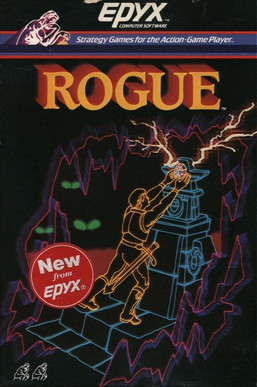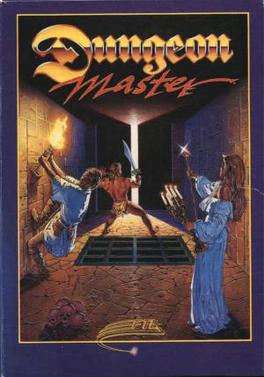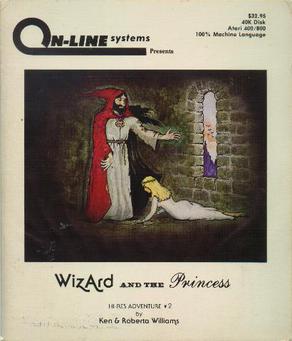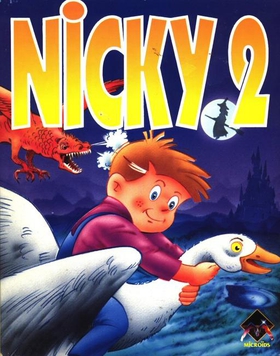
The Atari Lynx is a 16-bit fourth-generation hand-held game console released by Atari Corporation in September 1989 in North America and 1990 in Europe and Japan. It was the first handheld game console with a color liquid-crystal display. Powered by a 4 MHz 65C02 8-bit CPU and a custom 16-bit blitter, the Lynx was more advanced than Nintendo's monochrome Game Boy, released two months earlier. It also competed with Sega's Game Gear and NEC's TurboExpress, released the following year.

Rogue is a dungeon crawling video game by Michael Toy and Glenn Wichman with later contributions by Ken Arnold. Rogue was originally developed around 1980 for Unix-based minicomputer systems as a freely distributed executable. It was later included in the Berkeley Software Distribution 4.2 operating system (4.2BSD). Commercial ports of the game for a range of personal computers were made by Toy, Wichman, and Jon Lane under the company A.I. Design and financially supported by the Epyx software publishers. Additional ports to modern systems have been made since by other parties using the game's now-open source code.

Shadow of the Beast is a platform game developed by Reflections and published by Psygnosis in 1989. The original version was released for the Amiga, and was later ported to many other systems. The game was known for its graphics, with many colours on screen and up to twelve levels of parallax scrolling backdrops, and for its atmospheric score composed by David Whittaker that used high-quality instrument samples.
Andrew Nicholas Oliver and Philip Edward Oliver, together known as the Oliver Twins, are British twin brothers and video game designers.

Wonder Boy in Monster Land, known by its original arcade release as Wonder Boy: Monster Land, is a platform video game developed by Westone Bit Entertainment and released by Sega in Japanese arcades in 1987 and for the Master System in 1988, with a number of other home computer and console ports following. The game is the sequel to the 1986 game Wonder Boy and takes place eleven years after the events in the previous game. After enjoying over a decade of peace on Wonder Land following the defeat of the evil King by Tom-Tom, later bestowed the title "Wonder Boy", a fire-breathing dragon called the MEKA dragon appeared; he and his minions conquered Wonder Land, turning it into "Monster Land". The people, helpless due to their lack of fighting skill, call for Wonder Boy, now a teenager, to destroy the monsters and defeat the MEKA dragon. Players control Wonder Boy through twelve linear levels as he makes his way through Monster Land to find and defeat the MEKA dragon. Players earn gold by defeating enemies and buy weapons, armor, footwear, magic, and other items to help along the way.

Christopher Hülsbeck, known internationally as Chris Huelsbeck, is a German video game music composer. He gained popularity for his work on game soundtracks for The Great Giana Sisters and the Turrican series.

Dungeon Master is a role-playing video game featuring a pseudo-3D first-person perspective. It was developed and published by FTL Games for the Atari ST in 1987, almost identical Amiga and PC (DOS) ports following in 1988 and 1992.

Factor 5 GmbH is an independent software and video game developer. The company was co-founded by five former Rainbow Arts employees in 1987 in Cologne, Germany, which served as the inspiration behind the studio's name.

There have been several video games based on the 1991 film Hook. A side-scrolling platform game for the Nintendo Entertainment System (NES) and Game Boy was released in the United States in February 1992. Subsequent side-scrolling platform games were released for the Commodore 64 and the Super Nintendo Entertainment System (SNES), and an arcade beat ‘em up by Irem later in 1992, followed by versions for the Sega CD, Sega Genesis, and Sega's handheld Game Gear console in 1993.

Quest for Glory: So You Want to Be a Hero is a 1989 adventure game/role-playing game hybrid, designed by Lori Ann Cole and published by Sierra On-Line for MS-DOS. It is the first game in the Quest for Glory series, and has been credited for being a genre-defining game, as it tried to mix graphical adventure gaming with role-playing-like elements such as statistic building that would actually affect the ability to accomplish certain parts of the game. The game has a satirical and silly tone. Ports for the Amiga, Atari ST, and NEC PC-9801 were released in the early 1990s. A VGA remake, titled Quest for Glory I: So You Want to Be a Hero, was released in 1992 for DOS and later in 1994 for Mac OS.

Metal Mutant is a side-scrolling action-adventure game developed and published for MS-DOS, Amiga, and Atari ST by Silmarils and released in 1991. The game allows the player to transform at any time into three different robot forms: Cyborg, Dino, and Tank.

Eutechnyx Limited is a British video game developer based in Newcastle upon Tyne, England. Since 1997, the company has focused on racing games. They are known for their largely panned video game Ride to Hell: Retribution, work with the NASCAR The Game franchise, and as a developer on various other racing titles and games.

Escape from the Planet of the Robot Monsters is a multidirectional shooter released in arcades by Atari Games in 1989. The game is styled after campy science fiction B movies of the 1950s. It was ported to the Amiga, Amstrad CPC, Atari ST, Commodore 64, MS-DOS, SAM Coupé, and ZX Spectrum.

Wizard and the Princess is a graphic adventure game written for the Apple II and published in 1980 by On-Line Systems. It is the second installment in the Hi-Res Adventures series after Mystery House. Unlike its predecessor, which featured monochrome drawings, Wizard and the Princess introduced color graphics. Ports for the Atari 8-bit computers and Commodore 64 were released in 1982 and 1984 respectively. The 1982 self-booting disk version for IBM PC compatibles was renamed Adventure in Serenia.
Non-games are a class of software on the border between video games and toys. The term "non-game game" was coined by late Nintendo president Satoru Iwata, who describes it as "a form of entertainment that really doesn't have a winner, or even a real conclusion". Will Wright had previously used the term "software toy" for the same purpose. The main difference between non-games and traditional video games is the lack of structured goals, objectives, and challenges. This allows the player a greater degree of self-expression through freeform play, since they can set up their own goals to achieve. Some genres that have been considered non-games include language-learning software, digital tabletop games, puzzle games, simulation games, and art games.

Temple of Apshai Trilogy is a remake of three games from the Dunjonquest series, Temple of Apshai, Upper Reaches of Apshai, and Curse of Ra.
Tiertex Design Studios Limited was a British software development company and former video game developer based in Macclesfield, England; it was founded in 1986, focusing on porting games to home computers and handheld platforms.

Dragon's Lair is an interactive film LaserDisc video game developed by Advanced Microcomputer Systems and published by Cinematronics in 1983, as the first game in the Dragon's Lair series. In the game, the protagonist Dirk the Daring is a knight attempting to rescue Princess Daphne from the evil dragon Singe who has locked the princess in the foul wizard Mordroc's castle. It featured animation by ex-Disney animator Don Bluth.

Nicky 2, or Nicky II, is a platform game developed and originally released for the Amiga, Atari ST, and MS-DOS by Microïds in 1992. It is a sequel to 1992's Nicky Boom in which the boy Nicky returns to fight evil forces. Its iPhone version was released as Nicky Boom 2 in 2009.

Planet of Lust is a 1989 erotic text adventure game developed and self-published by Free Spirit Software, and released for Commodore 64, DOS, Atari ST, and Amiga. The Amiga version of Planet of Lust was released in Europe in April 1989. Planet of Lust is the second game in the Brad Stallion series; it is preceded by Sex Vixens from Space (1988), and succeeded by Bride of the Robot (1989) and Sex Olympics (1991).

















